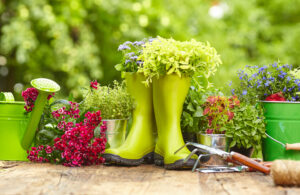
Water is, despite what most of us believe, a scarce commodity which really needs to be preserved and managed carefully, especially in the summer periods. We all love our gardens, though and any garden to be proud of needs watering or it simply withers and dies. So how do we strike a sensible compromise between saving water and saving our gardens? In this article we give some helpful tips to help you achieve the best of both worlds.

Water Butts
Even in the best summers, we do still get rain and installing water butts into your guttering downpipes is a great way to harvest water. Did you know that the average roof collects up to 85,000 litres of water per year? For the average 200 litre water butt that is over 400 refills. This water is also better for your plants as it isn’t treated to make it fit for human consumption and will contain the natural nutrients your garden will be craving.
Use Grey Water
Never heard of grey water? Quite simply this is water than comes from baths, showers, washing up and even the rinse cycle from the washing machine. Yes this water does tend to be contaminated with soaps and detergents but, according to the Royal Horticultural society, soil and composts are good at filtering these contaminants out. Do not use grey water on herbs or vegetables and fruits though, only on flowers and non-edible plants.
Water at cooler times of day
Watering when the weather is cooler, either early in the morning or later in the evening will make sure that the water doesn’t simply evaporate. This means your plants will retain more water and need to be watered less.
Leave your grass long
When we say long we don’t mean wait deep, but if you cut your grass too short it will dry out much more quickly and require more watering. At the worst, don’t water your grass at all, it might go brown and wilt, but grass is very hardy and it will bounce back the moment the rain starts again.
Use mulch
Where you have open beds and potted plants, cover them in a layer of coarse mulch. The mulch acts as an insulation layer that prevents water from evaporating from the soil. It needs to be coarse to ensure that the water can flow through to the soil.
Water sensibly
One question is always how much and how often to water plants. Now this is a difficult question to answer, but it is important to know that plants are very adaptable and will adjust to less water if they need to. Remember that plants take water from their roots so water at soil level and not onto the leaves as this will just waste water. According to the RHS, it makes more sense to water less often and more thoroughly to allow water to seep down to root level, especially during droughts where light watering is really not effective.
Drought resistant plants
As our summers become drier, not all plants in the UK will cope as they are used to copious amounts of water. There are a lot of very beautiful drought resistant plants that can be planted which require much less water. Plants such as Perovskia “blue Spire” and Spanish Broom will bring a splash of colour whilst coping with droughts.
Keep on top of the weeding
As much as we all hate having to weed our gardens, weeds are also plants and need water. Keeping on top of the weeding will reduce the amount of water your garden needs and you can use your precious water only for the plants you really want to keep.
Use a can rather than a hose
When watering your garden use a watering can rather than a hose. You will be more aware of the amount of water you are using and a can uses far less water than a hose.
Watering your garden is a must especially in the hottest times of the year, but preserving water is also important. By following some of the tips above, you will be able to strike a sensible compromise between water sustainability and having a beautiful garden.



